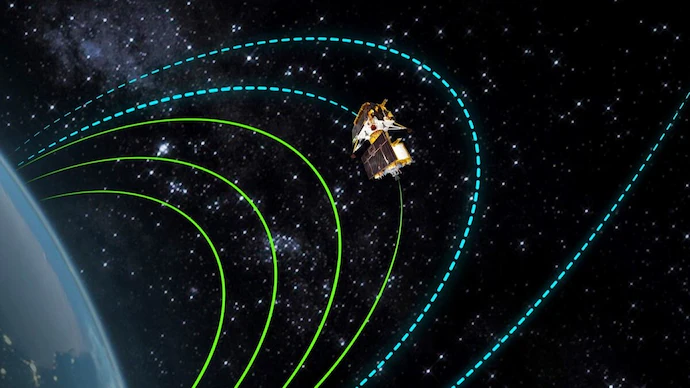Chandrayaan-3 is a testament to India’s spirit of innovation and exploration, as well as its collaboration with other countries
The moon is the closest celestial body to Earth, and has fascinated humans for centuries. It is also a valuable source of scientific knowledge and resources. Many countries have launched missions to explore and study the moon, and India is one of them. India’s lunar programme, called Chandrayaan, which means “mooncraft” in Sanskrit, has achieved remarkable feats in the past.
First Chandrayaan-1
The first mission, Chandrayaan-1, orbited the moon in 2008 and discovered traces of water on the lunar surface.
Chandrayaan-2
The second mission, Chandrayaan-2, consisted of an orbiter, a lander and a rover, but the lander lost contact with the ground station during the final descent and crashed on the moon in 2019. The orbiter is still functioning and sending data to Earth.
The third mission, Chandrayaan-3, is India’s latest attempt to land a rover on the moon’s south pole, a region of scientific interest and potential resources. This essay will discuss the details, challenges and significance of Chandrayaan-3, India’s third lunar mission.
Details of Chandrayaan-3
Chandrayaan-3 is similar to Chandrayaan-2, but with some improvements and modifications. It consists of a lander named Vikram and a rover named Pragyan, which are identical to those of Chandrayaan-2. However, it does not have an orbiter, as it uses the orbiter of Chandrayaan-2 for communication and navigation. The lander and rover are designed to withstand the harsh environment of the moon and operate for one lunar day (14 Earth days).
Launch Date
Chandrayaan-3 was launched on July 15, 2023, using a Russian launch vehicle called Soyuz-FG from Baikonur Cosmodrome in Kazakhstan. It took about a month to reach the moon’s orbit, where it performed several maneuvers to adjust its trajectory and speed. It is expected to touch down on the lunar surface on August 23, 2023, near the south pole of the moon.
Investment
The mission cost is estimated at $74.6 million, which is much lower than other lunar missions. India has a reputation for frugal space engineering, as it adapts existing technology and employs highly skilled engineers who earn less than their foreign counterparts. The mission also benefits from international collaboration, as it uses a launch vehicle provided by Russia and a landing site selected by NASA.
Challenges of Chandrayaan-3
Chandrayaan-3 is a challenging mission that involves many risks and uncertainties. The most difficult part of the mission is the soft landing on the moon, which requires precise timing, accuracy and control. The lander has to decelerate from about 6 km/s to zero in about 15 minutes, while avoiding obstacles and craters on the surface. The lander also has to autonomously detect and avoid hazards using its sensors and cameras.
Another challenge is the communication delay between Earth and the moon, which is about 2.5 seconds one way. This means that there is no real-time control or feedback from the ground station during the landing phase. The lander has to rely on its onboard computer and software to execute the landing sequence.
A third challenge is the extreme temperature variation on the moon, which can range from -173°C to 127°C depending on whether it is day or night. The lander and rover have to survive these fluctuations using thermal insulation and heaters.
Significance of Chandrayaan-3
Chandrayaan-3 is a significant mission that has many scientific and strategic implications for India and the world. The mission aims to explore the south pole of the moon, which is a region of scientific interest and potential resources. The south pole has craters that are permanently shadowed from sunlight, and may contain water ice and other minerals. The rover will conduct experiments to study the lunar soil, rocks, temperature and radiation.
The mission will also test new technologies for future lunar missions, such as soft landing, hazard avoidance and autonomous navigation. These technologies can be useful for other planetary exploration missions as well.
The mission is also a source of pride and inspiration for India, as it demonstrates its technological prowess and scientific curiosity. It also contributes to the global understanding of the moon and its history. If successful, Chandrayaan-3 will make India the fourth country to achieve a soft landing on the moon, after the US, Russia and China. It will also be the first mission to land near the lunar south pole, which has never been explored before.
Conclusion
Chandrayaan-3 is India’s third lunar mission, which aims to land a rover on the moon’s south pole. It is a follow-up to the Chandrayaan-2 mission, which failed to achieve a soft landing in 2019. Chandrayaan-3 is similar to Chandrayaan-2, but with some improvements and modifications. It does not have an orbiter, as it uses the orbiter of Chandrayaan-2 for communication and navigation.
The lander and rover are designed to withstand the harsh environment of the moon and operate for one lunar day. The mission was launched on July 15, 2023, using a Russian launch vehicle, and is expected to touch down on the lunar surface on August 23, 2023. The mission cost is estimated at $74.6 million, which is much lower than other lunar missions.
Chandrayaan-3 is a challenging mission that involves many risks and uncertainties. The most difficult part of the mission is the soft landing on the moon, which requires precise timing, accuracy and control. The lander has to autonomously detect and avoid hazards using its sensors and cameras. Another challenge is the communication delay between Earth and the moon, which is about 2.5 seconds one way. A third challenge is the extreme temperature variation on the moon, which can range from -173°C to 127°C depending on whether it is day or night.
Chandrayaan-3 is a significant mission that has many scientific and strategic implications for India and the world. The mission aims to explore the south pole of the moon, which is a region of scientific interest and potential resources. The rover will conduct experiments to study the lunar soil, rocks, temperature and radiation. The mission will also test new technologies for future lunar missions, such as soft landing, hazard avoidance and autonomous navigation. The mission is also a source of pride and inspiration for India, as it demonstrates its technological prowess and scientific curiosity. It also contributes to the global understanding of the moon and its history.
Chandrayaan-3 is a testament to India’s spirit of innovation and exploration, as well as its collaboration with other countries. It is also a valuable opportunity for students to learn more about the moon and its mysteries. As Prime Minister Modi said in his tweet, “Let’s go!” 🚀🌕







